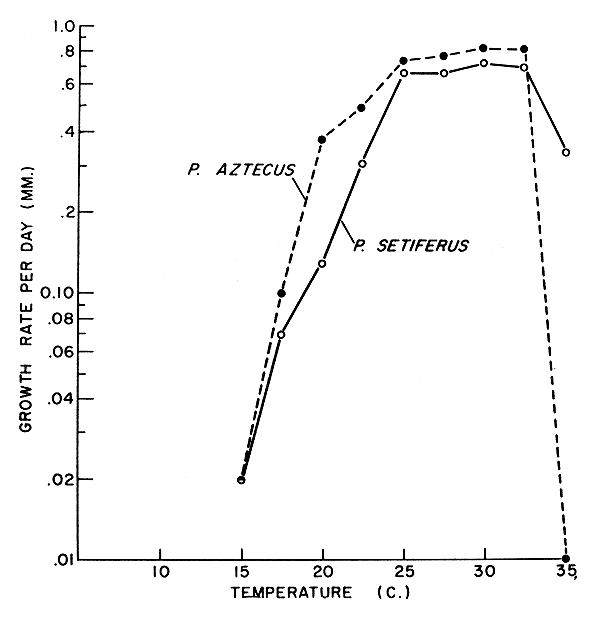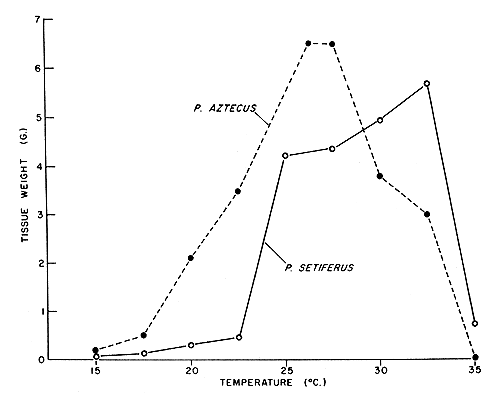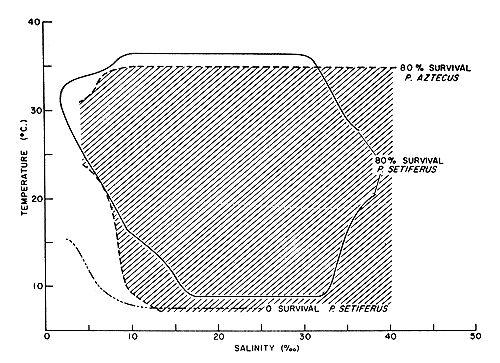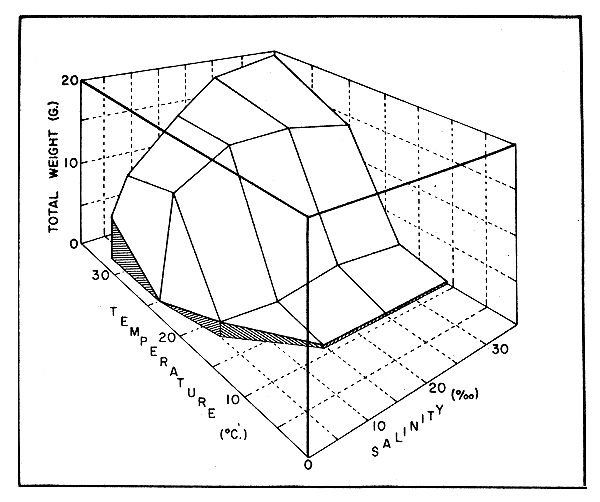by
ZOULA P. ZEIN-ELDIN and GEORGE W. GRIFFITH
Bureau of Commercial Fisheries, Biological Laboratory
Galveston, Texas 77550
Abstract
Growth and survival experiments conducted in the laboratory on postlarval Penaeus aztecus Ives and P. setiferus (Linnaeus) showed that, in general, both species tolerated a broad range of temperature and salinity, but some differences between species existed. At specific temperatures which ranged from 11° to 35°C, P. aztecus was more tolerant than P. setiferus of temperatures of 15°C or lower. In contrast, P. setiferus was more tolerant than P. aztecus at 30° to 35°C. Test salinities between 2 and 40‰ showed that P. aztecus tolerated higher salinities than did P. setiferus. Specific combinations of salinity and temperature were tested to determine whether these factors interacted to affect postlarval shrimp. Combinations of low temperature and low salinity were detrimental. The effects of salinity and temperature on growth, survival, and tolerances of postlarval as observed in the laboratory are discussed as related to overwintering of postlarval P. aztecus; rate of growth as observed in nature; time of entry of the two species into the nursery areas; and the effects of simultaneous decrease of salinity and temperature.
EVALUATION DE L'EFFET DE LA SALINITE ET DE LA TEMPERATURE SUR LA CROISSANCE ET LA SURVIE DES POSTLARVES DE PENAEIDAE
Résumé
Des expériences de laboratoire conduites sur des postlarves de Penaeus aztecus Ives et de P. setiferus (Linnaeus) du point de vue de la croissance et de la survie ont révélé que, dans l'ensemble, ces deux espèces s'accommodaient d'une gamme étendue de températures et de salinités, tout en accusant certaines différences. Durant une épreuve comportant l'exposition à diverses températures échelonnées de 11° à 35°C, P. aztecus a manifesté une plus grande tolérance que P. setiferus jusqu'à 15°C tandis que de 30° à 35°C c'est le contraire qui s'est produit. Au cours d'expériences durant lesquelles le taux de salinité a varié de 2 à 40‰, P. aztecus a mieux supporté les salinités élevées que P. setiferus. Diverses combinaisons de salinité et de température ont été expérimentées afin de déterminer si l'action conjugée de ces facteurs jouait un rôle dans le développement des postlarves. On a noté l'effet nocif de la combinaison basse température et basse salinité. Les incidences de la salinité et de la température sur la croissance et la survie ainsi que les divers degrés de tolérance des postlarves constatés au laboratoire sont examinés des points de vue suivants: hivernage des postlarves de P. aztecus, taux de croissance à l'état naturel; époque de pénétration des deux espèces dans les zones de développement des jeunes; et conséquences d'une baisse simultanée de la salinitée et de la température.
EVALUACION DE LOS EFECTOS DE LA SALINIDAD Y LA TEMPERATURA EN EL CRECIMIENTO Y SUPERVIVENCIA DE LOS PENEIDOS POSTLARVALES
Extracto
Los experimentos sobre crecimiento y supervivencia realizados en el laboratorio con formas postlarvales de Penaeus aztecus Ives y P. setiferus (Linnaeus) indicaron que, en general, ambas especies toleraban un amplio margen de temperatura y salinidad, pero que existían algunas diferencias entre ambas. A temperaturas específicas que oscilaban de 11° a 35°C, P. aztecus era más tolerante a las temperaturas de 15°C o más bajas, que P. setiferus. En cambio, P. setiferus toleraba mejor que P. aztecus las temperaturas de 30° a 35°C. Las salinidades de ensayo entre el 2 y el 40 por mil indicaron que P. aztecus toleraba salinidades más elevadas que P. setiferus. Se ensayaron combinaciones específicas de salinidad y temperatura para determinar si la interacción de estos factores influía en los camarones postlarvales. Las combinaciones de baja temperatura y poca salinidad eran perjudiciales. Se examinan los efectos observados en el laboratorio de la salinidad y la temperatura sobre el crecimiento, supervivencia y tolerancias de las formas postlarvales, en relación con la supervivencia en el transcurso del invierno de las postlarvas de P. aztecus; el ritmo de crecimiento tal como se observa en la naturaleza; el período de entrada de las dos especies en las zonas de cría; y los efectos de la disminución simultánea de la salinidad y la temperatura.
The general life history of the three species of Penaeus, which are of commercial value to the North American shrimp fishery, is well known. The animals hatch and undergo the first stages of development in a relatively stable environment - the open ocean. The succeeding stage, in which growth is most rapid, is spent in a relatively unstable environment - the estuary. Then the animal returns to the open sea to spawn (Williams, 1965).
Observations made in the field suggest that the three species - P. aztecus Ives, the brown shrimp; P. duorarum Burkenroad, the pink shrimp; and P. setiferus (Linnaeus), the white shrimp - have somewhat different tolerances or preferences for certain environmental factors (Williams, 1965; Broad, 1965). These observations, however, leave many questions unanswered. We may well ask whether it is salinity alone, or the factors which accompany decreasing salinity (vegetation, fauna, light penetration, substrate type) that influence the distribution of the species. Again, how does temperature affect each species? Do salinity and temperature interact to limit the population? Do they affect the species in the same way at all seasons of the year? Are all age groups within a species affected by the environment in the same way?
We have chosen to study these questions through controlled laboratory experiments. Although conditions in these experiments do not closely approach those of the natural environment, they do permit the isolation of single factors.
Our methods have been fully described in several papers (Zein-Eldin, 1963; Zein-Eldin and Aldrich, 1965; Zein-Eldin and Griffith, 1966) and are given only briefly here.
We have conducted two types of experiments. In the first type, individual survival was the sole criterion for the suitability of the environment. These survival experiments required less than 48 h - 12 to 24 h for changing the experimental conditions (acclimation), and 24 h for testing. Because acclimation changes in such experiments were rapid and drastic, resulting data were used to delimit the extremes of species tolerance and to guide us in further studies. Most of our studies have been done with postlarvae although juveniles and subadults also have been tested.
In the second type of study, the acclimation period was lengthened to about 48 to 72 h, and the animals were exposed to test conditions for about 1 mo. The mean increase in size of the animals was used as the index of the suitability of the environment.
For these experiments, postlarvae were collected from tidal passes and held in a storage tank for at least 24 h before testing. We usually placed 100 animals in each experimental tank - a standard 65-l glass aquarium with a subsurface filter covered with sterilized ground oyster shell and sand (Zein-Eldin, 1963). Tank water was initially 25‰ salinity. Salinity adjustments, when required, were made with distilled water or with concentrated sea water. Temperature adjustments were made in one of four constant temperature rooms or in B.O.D. - type incubators. Light also could be controlled in these chambers, but unless specified, all experiments were conducted under continuous fluorescent light.
Several foods were tested: a brown and a blue-green alga, ground fish, ground shrimp, live nauplii of the brine shrimp Artemia salina, and a combination of live brine shrimp and algae (Zein-Eldin, 1963). Animal food was necessary for the best growth. The presence of an excess of ground food, however, soon caused the tanks to foul. As a result, we fed only measured amounts of live brine shrimp.
At 5-day intervals, we removed 10 animals from each experimental tank. Each individual was dried in a soft paper towel, weighed to the nearest 0.1 mg with a semiautomatic balance, and measured (rostrum-telson length) to the nearest 0.5 mm.
3.1 Salinity
Salinity is the factor most commonly correlated with abundance of juvenile and subadult penaeids (Gunter, 1950; Gunter, 1961a, 1961b; Gunter, Christmas and Killebrew, 1964; Williams, 1965; Broad, 1965). It has been suggested that the abundance of shrimp is greatest in low salinity, and that the smallest animals occur in the lowest salinities (Gunter, 1950). Frequently, this relation has been interpreted to mean that very low salinities are necessary for young shrimp to survive in the estuaries. The salinity varies in estuarine waters of Texas, depending upon season and year, from almost fresh (e.g. Trinity River delta; data from estuarine program of the Galveston Biological Laboratory) to the hyper-salinities (45‰ and above) of Laguna Madre (Simmons, 1957). Young shrimp occur in all of these areas.
Because of the apparent importance of salinity, our first experiments were designed to assess the salinity requirements of P. aztecus. The results indicated that, at temperatures of 23–25°C and with food supplied in excess, postlarvae grew equally well at salinities of 2 to 40‰; survival was 90–100 percent (Zein-Eldin, 1963). Our earliest conclusion, therefore, was that low salinity was neither a requirement for nor a detriment to either growth or survival of postlarval brown shrimp.
3.2 Temperature
Field observations concerning the effects of temperature upon penaeid shrimp are relatively few. Most articles discuss low temperature only (Gunter and Hildebrand, 1951). To determine temperature effects on postlarval brown and white shrimp, we exposed postlarvae to constant temperatures of 15.0, 17.5, 20.0, 22.5, 25.0, 27.5, 30.0, 32.5, and 35.0°C for 1 mo.
In these experiments, groups of 20 postlarvae were held in 4-1 glass aquaria. Five groups were held at each temperature, without light.
Responses of P. aztecus and P. setiferus to temperatures below 25°C, were different (Fig. 1). Growth rate of P. aztecus increased rapidly between 15 and 20°C; continued to increase, but at a slower rate, between 20 and 25°C. At 35°C, not only did growth rate decrease, but no animals survived more than 15 days (Zein-Eldin and Griffith, 1966).
The growth of P. setiferus increased at almost a constant rate with temperatures between 15 and 25°C (Griffith and Zein-Eldin, MS). Growth rate decreased between 32.5 and 35°C, so that postlarval P. setiferus reared at 35°C were about the same size as animals reared at 22.5°C.
Although growth of P. setiferus was the same at temperatures of 25–32.5°C in this series of experiments, other experiments performed in larger tanks (Zein-Eldin and Griffith, MS) suggested that increasing temperature continued to stimulate growth at temperatures greater than 25°C. Tank size or population density, or both, may affect growth rate (Zein-Eldin and Griffith, 1966). It is possible, therefore, that growth of P. setiferus increases with temperature at least to 32.5°C (Zein-Eldin and Griffith, MS).
The gross tissue production (total weight of tissue produced by all shrimp surviving the conditions for 1 mo) is another measure of the suitability of the environment. Because both the mean size of the survivor and the percentage survival are considered, it may be used to compare conditions in which a few large animals survive with those in which surviving individuals are smaller but more numerous. Comparisons of gross tissue production further emphasize the differential effect of temperature (Fig. 2). The production of P. aztecus tissue declined sharply at temperatures above 27.5°C but the production of P. setiferus tissue continued to increase. The difference was primarily caused by a decreased survival of P. aztecus at temperatures above 27.5°C (Zein-Eldin and Griffith, 1966).

Fig. 1 Growth rate (mm/day) of two species of postlarval penaeids exposed to various temperatures (data for P. aztecus from Zein-Eldin and Griffith, 1966; for P. setiferus, Griffith and Zein-Eldin, MS).
3.3 Combinations of salinity and temperature
3.3.1 Short-term survival Studies of 24-h survival in which percentage survival served as an indicator of tolerance have been conducted. Acclimation of the animals to test conditions, as previously reported, was rapid - completed in 12 to 24 h. For the lowest temperature (7.0°C) and salinity (2‰) tested, this acclimation represented a change of about 1.0°C per h, and a simultaneous decrease in salinity of about 1‰ per h.
The data indicated that the two species differed not only in temperature tolerances, but also in salinity tolerances (Fig. 3). Between 80 and 100 percent of postlarval P. aztecus withstood 24-h exposure to temperatures as low as 4–5°C (depending upon the season of collection) if salinity was about 25‰; yet, 100 percent of the animals died within 6 h if the temperature was reduced to 2°C (G. W. Griffith, unpublished records). P. setiferus has a low temperature limit of about 7°C under these same salinity conditions. At the other temperature extreme, over 90 percent of postlarval P. setiferus survived 35°C, but all died at 37.5°C (Table I).
TABLE I
Constant temperature at which 80 percent of the animals survive
(Salinity, 25‰)
| Species | Total length (mm) | Upper limit (°C) | Lower limit (°C) | Acclimation time (h) | Period of exposure (h) | References |
| Penaeus aztecus | 10–15 | 341 | 5–6 | 12 | 24 | 2,3 |
| Penaeus aztecus | 10–50 | 281 | 11–154 | 48 | 672 | 5,2 |
| Penaeus setiferus | 8–12 | >35<37.5 | >7.5<10 | 12 | 24 | 3 |
| Penaeus setiferus | 8–50 | >32.5<35 | 15 – 17.51 | 48 | 672 | 5, 6 |
| Penaeus setiferus | 50–100 | >35 | <7.5 | 12 | 24 | 3 |
1 Estimated
2 Zein-Eldin and Aldrich (1965)
3 G. W. Griffith (unpublished data)
4 Depends upon season at which postlarvae are caught
5 Griffith and Zein-Eldin (MS)
6 Zein-Eldin and Griffith (MS)

Fig. 2 Gross tissue production (g) by two species of postlarval penaeids exposed to various temperatures (data for P. aztecus from Zein-Eldin and Griffith, 1966; for P. setiferus, Griffith and Zein-Eldin, MS).

Fig. 3 Twenty-four h survival of two species of penaeids exposed to various combinations of salinity and temperature (data from Zein-Eldin and Aldrich, 1965; for P. setiferus, Griffith, unpublished).
3.3.2 One-month survival Survival in both species for 1 mo is somewhat less than that in the 24-h tests, in spite of a longer acclimation period (up to 4 days). P. setiferus, however, were able to withstand higher salinities in the 1-mo growth experiments than in the 24-h experiments. Low temperature, except at high salinities, apparently was less well tolerated by P. setiferus over a long period of time than over a short one. In P. aztecus, too, long exposure decreased survival under some experimental conditions. P. aztecus was generally less tolerant of the high temperatures (32 or 33°C) at all salinities. and did not survive combinations of low temperature (11°C) at salinities less than 15‰ (Zein-Eldin and Aldrich, 1965). Our data on the salinity and temperature survival limits of both P. aztecus and P. setiferus are summarized in Table I and II.
3.3.3 Growth The most extensive series of experiments which we have performed are those in which growth has been used as an index. We have tested P. aztecus and P. setiferus collected at various seasons of the year. Salinity and temperature combinations at which tests were made are listed in Table III.
TABLE II
Salinity at which 80 percent of the animals survive
(Temperature, 25°C)
| Species | Total length (mm) | Upper limit (‰) | Lower limit (‰) | Acclimation time (h) | Period of exposure (h) | References |
| Penaeus aztecus | 10–15 | >40 | <5 | 12 | 24 | 1 |
| Penaeus aztecus | 10–50 | >40 | 22 | 48 | 672 | 1 |
| Penaeus setiferus | 8–12 | 40 – 45 | 42 | 12 | 24 | 3 |
| Penaeus setiferus | 50–100 | >40 | <10 | 12 | 24 | 3 |
| Penaeus setiferus | 8–50 | >40 | <2 | 48 | 672 | 4 |
| Penaeus setiferus | 50–100 | >54 | 4 | 672 | 1,344 | 5 |
NOTE: Period of acclimation is apparently of extreme importance. We plan experiments to document this point. All above data refer to animals brought in from the sea.
1 Zein-Eldin and Aldrich (1965)
3 G. W. Griffith (unpublished data)
4 Zein-Eldin and Griffith (MS)
5 Griffith and Zein-Eldin (unpublished data)
Growth in both species was far more strongly affected by temperature at the same salinity than by salinity at the same temperature (Table IV). Little tissue was produced by either species at the lowest temperature tested. Growth in postlarval P. aztecus increased markedly with temperature between 18 and 25°C (Fig. 4). Above 25°C, increasing temperature had much less effect on growth.
Growth in P. setiferus also increased between 18 and 25°C (Fig. 5). Temperature above 25°C continued to have a marked effect at salinities of 5 and 15‰. Thus, twice as much tissue was produced by postlarval P. setiferus at the intermediate salinities than at salinities of 25 and 35‰. Salinity also affected P. aztecus at 32.5°C; the most tissue was produced at 35‰ (Fig. 4).
TABLE III
Salinity and temperature combinations tested
| Temperature (°C) | (Salinity, ‰) | |||||
| 2 | 5 | 15 | 25 | 35 | 40 | |
| 11 | W, B | W, B | W, B | W, B | W, B | 0 |
| 15 | 0 | W, B | 0 | W, B | 0 | W, B |
| 18 | W, B | W, B | W, B | W, B | W, B | 0 |
| 25 | W, B | W, B | W, B | W, B | W, B | 0 |
| 32 | W, B | W, B | W, B | W, B | W, B | 0 |
| 33 | 0 | W, B | 0 | W, B | 0 | W, B |
(W = P. setiferus; B = P. aztecus; 0 = no test made)
TABLE IV
Increase in mean total length (mm) of two species of Penaeus postlarvae exposed for one month to various combinations of salinity and temperature1
(Initial length of P. aztecus, 12.1 mm; P. setiferus, 6.1 mm 0 = no survivors)
| Salinity (‰) | Species | Temperature (° C) | |||
| 32 | 25 | 18 | 11 | ||
| 2 | P. aztecus | 22.7 | 0 | 0 | 0 |
P. setiferus | 25.1 | 19.9 | 2.0 | 0 | |
| 5 | P. aztecus | 27.5 | 21.8 | 6.2 | 0 |
P. setiferus | 27.9 | 14.0 | 2.3 | 0 | |
| 15 | P. aztecus | 18.9 | 25.3 | 7.0 | 0.5 |
P. setiferus | 25.9 | 17.7 | 1.7 | 0 | |
| 25 | P. aztecus | 31.0 | 23.1 | 8.0 | 0.6 |
P. setiferus | 22.5 | 18.4 | 2.5 | 0 | |
| 35 | P. aztecus | 26.2 | 22.3 | 6.2 | 0.3 |
P. setiferus | 18.7 | 15.1 | 2.1 | 1.1 | |

Fig. 4 Gross tissue production by P. azteous postlarvae exposed to various conditions of temperature and salinity (data from Zein-Eldin and Aldrich, 1965).

Fig. 5 Gross tissue production by P. setiferus postlarvae exposed to various conditions of temperature and salinity (data from Zein-Eldin and Griffith, MS).
Species differences in temperature and salinity tolerance as shown in the laboratory may help explain life histories. Postlarval P. aztecus enter the Galveston Bay system in large numbers during February and March (Baxter, 1963; Baxter and Renfro, 1967). This group of postlarvae is apparently spawned during the autumn of the preceding year, and overwinters in the open Gulf of Mexico (Temple and Fischer, 1967). These postlarvae appear to have survived low temperatures, growing very little, for a period of about 4 mo. In the laboratory, it has been shown that postlarval P. aztecus can survive temperatures as low as 11°C for 1 mo at salinities of the open Gulf (Zein-Eldin and Aldrich, 1965). Growth is insignificant at these temperatures in the laboratory.
Following entry into the nursery areas, postlarval P. aztecus do not grow rapidly until water temperatures exceed 20°C (St. Amant, Corkum and Broom, 1963). Similarly, significant growth of laboratory-held postlarval P. aztecus occurs only at temperatures of 20°C and above (Fig. 1); growth approaches maximal at 25°C.
Laboratory studies have shown that combinations of low temperature and salinity are detrimental to postlarval P. aztecus. Similar conditions may occur during the winter and spring in the nursery areas or estuaries. If they occur after the entrance of the spring group of postlarval P. aztecus, they could be catastrophic to the population (Gulf States Marine Fisheries Commission, 1964).
The bulk of the postlarval P. setiferus population is probably not exposed to low temperature in nature. P. setiferus does not become abundant in Texas estuaries until May when water temperatures are well above 25°C, and few enter estuaries as late as November when water temperatures are below 20°C (Baxter and Renfro, 1967). Thus, the inability of the postlarval P. setiferus to withstand cold is probably less important to the species than the tolerance for temperatures of 30°C and above (Figs. 2, 3 and 5) - temperatures to which postlarvae may well be exposed in the shallow, marshy nursery areas during the summer.
Baxter, K.N., 1963 Abundance of postlarval shrimp - an index of future shrimping success. Proc.Gulf Caribb.Fish.Inst., 15(1962):79–87
Baxter, K.N. and W.C. Renfro, 1967 Seasonal occurrence and size distribution of postlarval brown and white shrimp near Galveston, Texas, with notes on species identification. Fishery Bull.Fish Wildl.Serv.U.S., 66(1): 149–58
Broad, A.C., 1965 Environmental requirements of shrimp. In Biological problems in water pollution Third Seminar 1962, edited by C.M. Tarzwell, Cincinnati, Ohio, U.S. Div. of Water Supply and Pollution Control, pp. 86–91
Griffith, G.W. and Z.P. Zein-Eldin, MS The effect of temperature upon the growth of laboratory-held postlarval Penaeus setiferus
Gulf States Marine Fisheries Commission, 1964 Gulf Coast Research Laboratory. Rep.Gulf St. mar.Fish.Commn, 15 (1963–5): 15 p.
Gunter, G., 1950 Seasonal population changes and distributions as related to salinity of certain invertebrates of the Texas coast including the commercial shrimp. Publs Inst.mar.Sci.Univ.Tex., 1(2): 7–51
Gunter, G., 1961a Habitat of juvenile shrimp (Family Penaeidae). Ecology, 42(3): 598–600
Gunter, G., 1961b Some relations of estuarine organisms to salinity. Limnol.Oceanogr., 6(2): 182–90
Gunter, G. and H.H. Hildebrand, 1951 Destruction of fishes and other organisms on the south Texas coast by the cold wave of January 28–February 3, 1951. Ecology, 32(4): 731–6
Gunter, G., J.Y. Christmas and R. Killebrew, 1964 Some relations of salinity to population distributions of motile estuarine organisms, with special reference to penaeid shrimp. Ecology, 45(1):181–5
St. Amant, L.S., K.C. Corkum and J.G. Broom, 1963 Studies on growth dynamics of the brown shrimp, Penaeus aztecus, in Louisiana waters. Proc.Gulf Caribb.Fish.Inst. 15(1962):14–26
Simmons, E.G., 1957 An ecological survey of the Upper Laguna Madre of Texas. Publs Inst. mar.Sci.Univ.Tex., 4(2):156–200
Temple, R.F. and C.C. Fischer, 1967 Seasonal distribution and relative abundance of planktonic-stage shrimp (Penaeus spp.) in the northwestern Gulf of Mexico, 1961. Fishery Bull.Fish Wildl.Serv.U.S., 66(2):323–34
Williams, A.B., 1965 Marine decapod crustaceans of the Carolinas. Fishery Bull.Fish Wildl. Serv.U.S., 65(1):298 p.
Zein-Eldin, Z.P., 1963 Effect of salinity on growth of postlarval penaeid shrimp. Biol.Bull. mar.biol.Lab.Woods Hole, 125(1):188–96
Zein-Eldin, Z.P. and D.V. Aldrich, 1965 Growth and survival of postlarval Penaeus aztecus under controlled conditions of temperature and salinity. Biol.Bull.mar. biol.Lab., Woods Hole, 129(1):199–216
Zein-Eldin, Z.P. and G.W. Griffith, 1966 The effect of temperature upon the growth of laboratory-held postlarval Penaeus aztecus. Biol.Bull.mar.biol.Lab., Woods Hole, 131(1):186–96
Zein-Eldin, Z.P. and G.W. Griffith, MS Growth and survival of postlarval Penaeus setiferus under controlled conditions of temperature and salinity. 24 p.